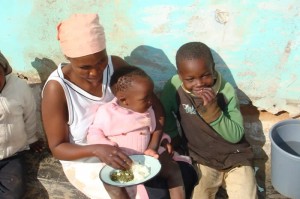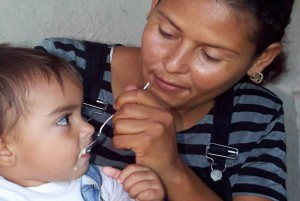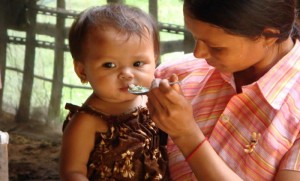By Marcia Griffiths, MSc, President, The Manoff Group
The malnutrition many children in poor countries experience does not occur overnight. It is the product of months of inadequate growth that leaves them both underweight and stunted before they are 2 years old. The charts depicting growth trends by standard deviation from the mean1 show that even within the first months of life, some children experience growth faltering. The prevalence of inadequate growth increases between 5 and 18 months of age and then stabilizes, with many fewer children faltering. Children can never recover their lost growth and intellectual development potential from this early growth retardation, and in the short term, it leaves many children malnourished, many more with mild or moderate than severe malnutrition. The risk of death is higher for the malnourished, and because of the high numbers of mild and moderately malnourished children, far more child deaths are associated with them than with the severely malnourished. Saving the majority of children who die from malnutrition-related causes requires action early, when growth faltering begins, not once there is the clinical malnutrition diagnosis.
 Acting early in a child’s life to prevent growth faltering requires an understanding of the causes of inadequate growth. One common cause is poor child feeding practices, particularly the practices after 6 months, when children need food to complement their breastmilk intake. The transition period from breastfeeding to a full family diet requires that caregivers perform a difficult balancing act to meet their child’s nutrient intake, which changes rapidly in the first two years of life. Because of the rapid changes in requirements, and the fact that different combinations of critical behaviors can yield adequate intakes, providing standard advice is not always effective. Throughout this transition period, food diversity, the energy and nutrient density of the food preparation, feeding frequency of both the complementary food and breast milk, and the quantity of food offered per meal must be balanced. If the key practices are not balanced for adequate intake, growth faltering results.
Acting early in a child’s life to prevent growth faltering requires an understanding of the causes of inadequate growth. One common cause is poor child feeding practices, particularly the practices after 6 months, when children need food to complement their breastmilk intake. The transition period from breastfeeding to a full family diet requires that caregivers perform a difficult balancing act to meet their child’s nutrient intake, which changes rapidly in the first two years of life. Because of the rapid changes in requirements, and the fact that different combinations of critical behaviors can yield adequate intakes, providing standard advice is not always effective. Throughout this transition period, food diversity, the energy and nutrient density of the food preparation, feeding frequency of both the complementary food and breast milk, and the quantity of food offered per meal must be balanced. If the key practices are not balanced for adequate intake, growth faltering results.
A review of information on child feeding practices from multiple Demographic and Health Surveys2 demonstrates that we are failing in our attempts to help caregivers perform this balancing act. Although we have woefully inadequate data on many aspects of young child feeding, we do have information about some of them—like continued breastfeeding, dietary diversity, and frequency of feeding. Among the different indicators, rates of continued breastfeeding beyond 6 months are the best, as 75 percent or more of the caregivers in more than half of the surveyed countries continue breastfeeding. The percentage of caregivers providing an adequate level of diversity in their child’s diet is just average—that is, in about half of the surveyed countries, between 50 and 75 percent of the caregivers are meeting the recommendation. In only 11 percent of the countries were 75 percent or more of the caregivers providing adequate dietary diversity. And feeding frequency is poor. In only 6 percent of surveyed countries were 75 percent or more of the caregivers offering food the recommended number of times per day. In more than half the countries, fewer than half the caregivers reached an adequate feeding frequency for the age of their child.
 The real shock comes when we look at these three behaviors simultaneously. In no country surveyed were more than 75 percent of caregivers practicing all three behaviors together. And only a few countries had half or more of their caregivers meeting these three indicators. I suspect, if we had data on other key aspects required for adequate growth, like energy/nutrient density or food quantity, the result would be even worse. No wonder growth faltering is so universal.
The real shock comes when we look at these three behaviors simultaneously. In no country surveyed were more than 75 percent of caregivers practicing all three behaviors together. And only a few countries had half or more of their caregivers meeting these three indicators. I suspect, if we had data on other key aspects required for adequate growth, like energy/nutrient density or food quantity, the result would be even worse. No wonder growth faltering is so universal.
What can be done to improve this situation? Many practitioners immediately assume that food (or other economic) assistance is the only solution because of widespread poverty and food insecurity. Experience in widely varying country settings tells a different story. Participatory qualitative research that involves families in improving their young child feeding practices has demonstrated that in all but emergency settings, the vast majority of families can do more, even with meager resources, to feed their children better.3 For this reason, in all settings, it is critical to find out what people can and cannot do to improve their feeding practices. Lessons from global programs show that the following key strategies can promote more successful child feeding:
- Listen and learn from caregivers. Nothing can substitute for understanding the reasons why caregivers do what they do. Equally important is understanding caregivers’ reactions to and uptake of new recommended behaviors. Knowing what influences the trial and continued use of a new practice is often of greater importance than understanding why people follow their current practices.
- Abandon the sole focus on “silver bullet” foods; feeding practices will always play an important role. In the past few years, the search for and promotion of new, nutrient-dense, manufactured foods has been an almost sole pursuit of those working to improve the nutrition of young children. This may be a reasonable emergency response, but it is not appropriate for the great majority of (mild and moderately) malnourished children, and it is not a very sustainable solution. Successful complementary feeding is about more than just food. The most nutritious food will have little impact if not fed properly, with appropriate frequency, as part of a diverse diet, with successful feeding approaches that help the child graduate to family foods. The new foods that are the subject of attention today are only short-term solutions because they are expensive, usually provided by donor groups, and are designed to treat malnourished children. Caregivers need options that can be sustained locally and that help them with the daily balance of practices needed for sustaining healthy growth in their children.
- Improve caregiver access to as many quality food choices as possible. The point above highlights the need to balance improved foods with improved practices, but even as programs strive to help caregivers improve food quality, the ideal is not just one food, but rather, a range of options, from improved homemade foods, to home fortificants, to improved local-vendor foods, to community-processed or commercial fortified foods. The more options there are, the more likely caregivers will find one that meets their needs, which may change radically depending on the season, their work status, or proximity to a market.
- Give caregivers tools to help them improve practices. Too often, people say that caregivers just won’t change their practices. But facilitating change is the essence of our role, and we need to bring a lot of creativity to this work to find solutions that help caregivers improve their everyday practices. For example, many caregivers feed too little at each meal because they are uncertain about how much they should feed, they fear that their child will become sick from eating too much, or they don’t want their child to become “spoiled” by becoming accustomed to “a lot” of food. A tool such as a low-cost child feeding bowl, with markings that suggest appropriate meal amounts for different ages, gives caregivers the confidence to offer an age-appropriate portion and allows them to measure what the child eats.
- Provide tailored advice and demonstrations. Just as one food will not work for everyone, so standardized messages must be tailored. A message to feed a child five times a day needs different discussions if it is being used with a caregiver in Eritrea who is feeding her child twice a day or with a caregiver in Kazakhstan who feeds her child biscuits and tea as many as ten times per day. Caregivers can benefit from advice tailored to their specific needs, delivered with the help of locally appropriate counseling tools, as well as individual or group demonstrations that build their confidence that they can undertake new practices and that their child will like the new practice or food.
 The challenge facing the nutrition community in reducing rates of undernutrition goes beyond the offer of nutrient-dense foods. Addressing the problem requires approaches that help caregivers find an appropriate balance among many critical feeding practices as they nourish their children during the critical first two years of life. The success of our work should be judged by reductions in the number of children who fail to grow adequately rather than by the numbers of moderately or severely malnourished children who are rehabilitated. The real challenge is interrupting the growth faltering process, not responding to the malnutrition it causes.
The challenge facing the nutrition community in reducing rates of undernutrition goes beyond the offer of nutrient-dense foods. Addressing the problem requires approaches that help caregivers find an appropriate balance among many critical feeding practices as they nourish their children during the critical first two years of life. The success of our work should be judged by reductions in the number of children who fail to grow adequately rather than by the numbers of moderately or severely malnourished children who are rehabilitated. The real challenge is interrupting the growth faltering process, not responding to the malnutrition it causes.Comments and responses for Meeting the challenge of growth faltering:
Dear Marcia Griffiths,
As an advisor to an infant feeding program I read with great interest your article on “Meeting the challenge of growth faltering.”
I am currently working with a small program that provides cash transfers, formula milk, and commodities (corn snacks and soya milk) to infants of HIV positive mothers. The program is an extension to a very comprehensive and long-term PMTCT program which provides follow-up for the mother and infant for one year after delivery. The extension began with infants who had graduated from the program returned with mild and moderate malnutrition at around 12-18 months of age.
Just as you mentioned in your article, I would like to refocus our efforts in reducing the number of infants who fail to grow, especially because we have access to these children from the time they are born. Additionally, we have encountered many problems with the cash transfers and giving food, mainly because we know that this extra assistance is shared among all family members and does not necessarily go to the malnourished child.
In your article you said that “Participatory qualitative research that involves families in improving their young child feeding practices has demonstrated that in all but emergency settings, the vast majority of families can do more, even with meager resources, to feed their children better.” Do you believe this to also be the case among HIV infected and affected families?
I also liked your suggestion of a child feeding bowl with markings. Do you have suggestions for anything else along those lines?
Thank you for your contribution.
Kind regards,
Tracy Kaye, MHS
International Development Fellow
Catholic Relief Services
________________________________________________________________________________________
Dear Tracy Kaye,
Your question focuses attention on an important segment of families who need special support as they feed their young children. Whether HIV-infected and affected families can do more with the resources available to them to improve young child feeding—even without being provided with additional food and/or resources—is highly dependent on the individual family’s situation and the cause of the child feeding problems. However, I believe the answer to your question for the majority of families is yes, they can do more. I say this because we have seen HIV-infected and affected families highly motivated to do what they can to for their child’s health and nutrition. But, whether their improvements will be sufficient to maintain growth will vary just as it does within any community. Even within a low-income community at risk for or suffering from undernutrition without the impact of HIV-AIDS, our research usually shows a high degree of variability. So, while most families can do more with support for improved practices, it is typical to find a small proportion of households, about 10-15 percent, that have difficulty maintaining the nutrition and health of their children without additional resources or support. Although many families who are suffering the worst consequences of HIV/AIDS likely would fall into this category, not all of them would. The family’s contribution should be understood and recognized as program responses are planned.
You are in a good position to examine this question because your program has contact with children from the time that they are born. Among issues your inquiry could examine are the ability of these families to meet their special challenges such as, the approximately 10 percent increased energy requirements of young children due to the illness, and the poor or missing care if the mother is extremely ill. Also, given your report that many children are mild to moderately malnourished by 18 months, an indication that growth faltering may have begun earlier, any inquiry should cover these children’s second year of life to identify the kind of support needed by these children through the vulnerable period of the first 24 months of age.
One additional note on feeding recommendations in HIV-affected areas: the blanket distribution of formula for HIV-affected mothers is not appropriate, and is, in fact, extremely dangerous. Any movement in this direction must be strongly counteracted. Please see the IYCN website’s “HIV and Infant Feeding” resource page (especially the PATH “Challenging Assumptions: Breastfeeding and HIV/AIDS” document) for more information or contact Tom Schaetzel at the IYCN Project.
Finally, additional information on the feeding bowl is available through this link.
Thank you,
Marcia Griffiths
Dear IYCN,
I read Marcia Griffith’s article on growth faltering with interest, particularly with reference to the 5-18 month period of time when inadequate growth increases. It also occurs to me that this is a period of time when women, dependent on breastfeeding practices, may be at risk for unintended pregnancy. In some countries, we see as many as 25% of births spaced less than 24 months apart, meaning that those women became pregnant before 15 months– with the vast majority of these pregnancies being unintended. With the introduction of supplemental foods, breastfeeding diminishes and fertility returns.
Do you have information on the relationship between pregnancy and growth faltering, since we know that in many cultures women wean abruptly if they are pregnant? Do you consider this to be a factor influencing patterns of growth faltering?
I imagine that you may be familiar with a recent article by Tilley, which using data from Egypt indicates that breasfeeding women with unplanned pregnancies were less likely to have used contraception than women who had weaned, suggested that prolonged brestfeeding contributes to unmet contraceptive need.
I think from this article we can see that it isn’t prolonged breastfeeding which is the issue, it is the mistaken belief that BF is protective and prevents fertility return.
It seems that we should be able to identify opportunities for FP and IYCF programs to work together to address this issue.
Catharine McKaig, DrPH, MS
Director, ACCESS-FP
Jhpiego
__________________________________________________________________________
Dear Catharine McKaig,
The link between undernutrition (and the growth faltering that precedes it), child mortality and short birth intervals is well established. Birth spacing is a critical action in the effort to improve nutrition, both the nutrition of the mother and the infant. Although there are many ways that birth spacing improves nutrition, one of them is in reducing the risk of abrupt weaning (the rapid cessation of breastfeeding) due to pregnancy. Abrupt weaning not only robs children of the nutrients they need from breast milk, it also often results in other feeding problems because of the dramatic change.
There are many anecdotal reports of the detrimental practice of abrupt weaning. I saw a case in point during a recent trip to Rwanda. It was remarkable to me that four mothers among a very small sample in a qualitative research study I was reviewing had abruptly weaned their young children between 12 and 18 months because of pregnancy. The diets of all four of these children were poor and if the young children were not already experiencing growth faltering, they would soon. Recently, abrupt weaning has become an issue because of the link between HIV/AIDS transmission and breastfeeding and the detrimental consequences to the child of cessation of breastfeeding are evident in these situations. We also know anecdotally that in some countries a high number of children end up in treatment for severe acute malnutrition because their mothers abruptly stop breastfeeding them when they become pregnant.
Promotion of breastfeeding should not inhibit the promotion of effective family planning messages and practices for many reasons, one of which is that while breastfeeding during pregnancy is not harmful to the mother or fetus, the cultural belief that breastfeeding should stop with pregnancy is so strong that use of modern family planning methods is a key strategy for avoiding the severe consequences for children of abrupt weaning. As you suggest, IYCF and FP programs should be integrated to ensure that mothers understand the limitations of breastfeeding for preventing pregnancy and have access to modern methods of contraception that will not interfere with breastfeeding. Helping to create longer birth intervals is best for the health and well-being of both the child and mother.
Thank you,
Marcia Griffiths
1. Shrimpton R, Victora CG, de Onis M, Lima RC, et al. Worldwide timing of growth faltering; implications for nutritional interventions. Pediatrics.2001;107(5):E75.
2. Mukuria AG, Kothari MT, Abderrahim N. Infant and Young Child Feeding Update. Calverton, Maryland: ORC Macro; 2006.
3. Based on a review of 26 qualitative research studies of young child feeding practices using the Trials of Improved Practices Methodology conducted in poor communities in Latin America, South and Southeast Asia, and Africa.
Date: Jul 6, 2009 | Category: Points of view
